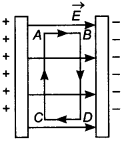Electrostatic Potential and Capacitance Class 12 Physics MCQs Pdf
41. What is the work done in moving a test charge q through a distance of 1 cm along the equatorial axis of an electric dipole?
Answer/Explanation
Answer:
Explaination: Zero.
42. A metal sphere is surrounded by an uncharged concentric thin spherical shell with a charge q and the potential difference between them is V. What is the new potential difference between them, if the shell is now given an additional charge q?
Answer/Explanation
Answer:
Explaination:
The potential difference remains unchanged, because the addition of charge q
will increase the potential of both spherical shell and metal sphere by an equal
amount.
43. Why is electrostatic potential constant throughout the volume of the conductor and has the same value (as inside) on its surface? [Panchkula 2019, Delhi 2012]
Answer/Explanation
Answer:
Explaination:
As we know that the electrostatic field inside the conductor is zero, therefore
no work is done in moving a small test charge, within the conductor and on its
surface. We find there is no potential difference between the two points inside
or on the surface, which implies the electrostatic potential is constant
throughout.
44. A and B are two conducting spheres of the same radius, A being solid and B hollow. Both are charged to the same potential. What will be the relation between the charges on the two spheres?
Answer/Explanation
Answer:
Explaination:
Since the radii of both the spheres are same, and according to the
question,
The potential of sphered=potential of sphere B.
45. If a point charge +q is taken first from A to C and then from C to B of a circle
drawn with another point charge +q at centre, then along which path more work will
be done?

Answer/Explanation
Answer:
Explaination:
Since both the points A and B are equidistant from the electric charge +q.
∴ VA = VB
∴ Work done WA→C = q (VC– VA)
= q(VC – VB) = WB→C
= -WC→B
46. A uniform electric field E exists between two charged plates as shown in figure.
What would be the work done in moving a charge q along the closed rectangular path
ABCDA?

Answer/Explanation
Answer:
Explaination:
Work done in moving a charge q along a closed rectangular path ABCD is
calculated as
W = WAB + WBC + WCD + WDA
W = qE + 0 – qE + 0 = 0 [∵ AB = CD]
47. “For any charge configuration, equipotential surface through a point is normal to the electric field.” Justify. [Delhi 2014]
Answer/Explanation
Answer:
Explaination:
If the electric field is not normal, it will have non-zero component along the
surface. In that case, the work done in moving a charge oh the equipotential
surface will not be zero.
48. What is the geometrical shape of equipotential surfaces due to a single isolated charge? [Delhi 2013]
Answer/Explanation
Answer:
Explaination: The geometrical shape is spherical.
49. Why is there no work done in moving a charge from one point to another on an equipotential surface? [Foreign 2012]
Answer/Explanation
Answer:
Explaination:
Potential difference between any two points of an equipotential surface is zero.
So no work is done in moving a charge from one point to another.
50. Can two equipotential surfaces intersect each other? Justify your answer. [Delhi 2011C]
Answer/Explanation
Answer:
Explaination:
Two equipotential surfaces cannot intersect. The direction of electric field is
always perpendicular to the equipotential surface. If they intersect, there will
be two directions of the electric field at the point of intersection which is
not possible.